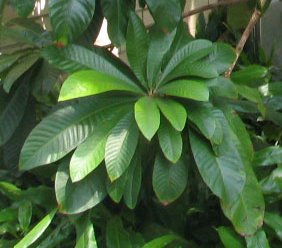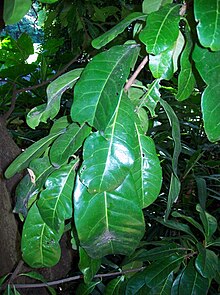
Hoya is a genus of over 500 accepted species of tropical plants in the dogbane family, Apocynaceae. Most are native to several countries of Asia such as the Philippines, India, Thailand, Malaysia, Vietnam, Bangladesh, Indonesia, Polynesia, New Guinea, and many species are also found in Australia.

The Sapotaceae are a family of flowering plants belonging to the order Ericales. The family includes about 800 species of evergreen trees and shrubs in around 65 genera. Their distribution is pantropical.

Manilkara zapota, commonly known as sapodilla, sapote, chicoozapote, chicoo, chicle, naseberry, or nispero, among other names, is a long-lived, evergreen tree native to southern Mexico, Central America and the Caribbean. An example natural occurrence is in coastal Yucatán in the Petenes mangroves ecoregion, where it is a subdominant plant species. It was introduced to the Philippines during Spanish colonization. It is grown in large quantities in Mexico and in tropical Asia including India, Pakistan, Thailand, Malaysia, Cambodia, Indonesia, Vietnam, Bangladesh.

Pouteria is a genus of flowering trees in the gutta-percha family, Sapotaceae. The genus is widespread throughout the tropical Americas, with outlier species in Cameroon and Malesia. It includes the canistel, the mamey sapote, and the lucuma. Commonly, this genus is known as pouteria trees, or in some cases, eggfruits.

Pouteria lucuma is a species of tree in the family Sapotaceae, cultivated for its fruit, the lúcuma. It is native to the Andean valleys of Bolivia, Chile, Ecuador, and Peru.

Sideroxylon is a genus of trees in the family Sapotaceae described as a genus by Linnaeus in 1753. They are collectively known as bully trees. The generic name is derived from the Greek words σιδηρος (sideros), meaning "iron", and ξύλον (xylon), meaning "wood."

Pandanus conoideus is a plant in the Pandanus family from New Guinea. Its fruit is eaten in Papua New Guinea and Papua, Indonesia. The fruit has several names: marita, or buah merah. The fruit is typically prepared by splitting it, wrapping it in leaves, and cooking it in an earth oven. making it a traditional delicacy.

Planchonella costata is a small coastal tree native to the northern North Island and to Norfolk Island (Australia). In New Zealand, its common name is tawapou ; on Norfolk Island it is called bastard ironwood. The name costata is from the Latin costatus (ribbed), a reference to the prominently raised primary nerves of the leaves.

Planchonella australis, also known by the synonym Pouteria australis, is a medium to tall rainforest tree of the family Sapotaceae native to Queensland and New South Wales, Australia. It is known by the common name black apple, wild plum, yellow buttonwood, black plum and yellow bulletwood.

Chrysophylloideae is a subfamily of flowering plants in the chicle family, Sapotaceae.

Cryptocarya obovata is a species of laurel growing on basaltic and fertile alluvial soils in eastern Australian rainforests. It is found from Wyong in New South Wales to Gympie in the state of Queensland. Extinct in the Illawarra region, allegedly last seen in the Illawarra in 1818 by Allan Cunningham. The species was included in the Prodromus Florae Novae Hollandiae et Insulae Van Diemen, 402 (1810)

Planchonella sandwicensis is a species of flowering tree in the sapodilla family, Sapotaceae, that is endemic to the main islands of Hawaii. Names for this species in the Hawaiian language include ʻĀlaʻa, Āulu and ʻĒlaʻa.

Pleioluma queenslandica, the blush condoo, is a large rainforest tree of the family Sapotaceae native to eastern Australia. It is found in sea side rainforest as well as the drier inland rainforests. From as far south as the Richmond River, New South Wales to Coen in tropical Queensland, and as far west as Melville Island, Northern Territory.
Planchonella is a genus of flowering trees in the gutta-percha family, Sapotaceae. Named in honour of Jules Émile Planchon, it was described by Jean Baptiste Louis Pierre. It contains around 110 mainly tropical species, which range from Pakistan through Southeast Asia and New Guinea to northern and eastern Australia, New Zealand, and the Pacific Islands. The genus is included in the larger genus Pouteria by some authorities, hence species such as Planchonella australis are also known as Pouteria australis.

Planchonella eerwah is a rare species of Australian rainforest tree in the family Sapotaceae. Common names include shiny-leaved condoo, black plum and wild apple. It is endemic to south eastern Queensland, with a restricted distribution and regarded as endangered.

Planchonella cotinifolia is an Australian tree in the family Sapotaceae. The common names include small-leaved plum, yellow lemon and small-leaved coondoo. It occurs in the drier rainforests from the Richmond River, New South Wales to the Wenlock River in tropical Queensland.
Planchonella myrsinoides is an Australian tree in the family Sapotaceae. The common names include yellow plumwood, axe-handle wood and blunt-leaved coondoo. It occurs in seaside rainforests and drier rainforests from the Forster, New South Wales to the Lakeland Downs in tropical Queensland.
Planchonella maclayana is a tree in the family Sapotaceae. It grows up to 18 m (60 ft) tall with a trunk diameter of up to 25 cm (10 in). The fruits are roundish, up to 1.3 cm (1 in) long.

The karuka is a species of tree in the Screwpine Family (Pandanaceae) and an important regional food crop in New Guinea. The nuts are more nutritious than coconuts, and are so popular that villagers in the highlands will move their entire households closer to trees for the harvest season.
Manilkara obovata is small to large sized evergreen tree within the Sapotaceae family. Its timber is sold under the name Nkunya in Uganda. The species has a wide distribution from Sierra Leone in West Africa moving east to Uganda in Eastern Africa and southwards to Zambia. It is also considered a variable species having different ecotypes.



















